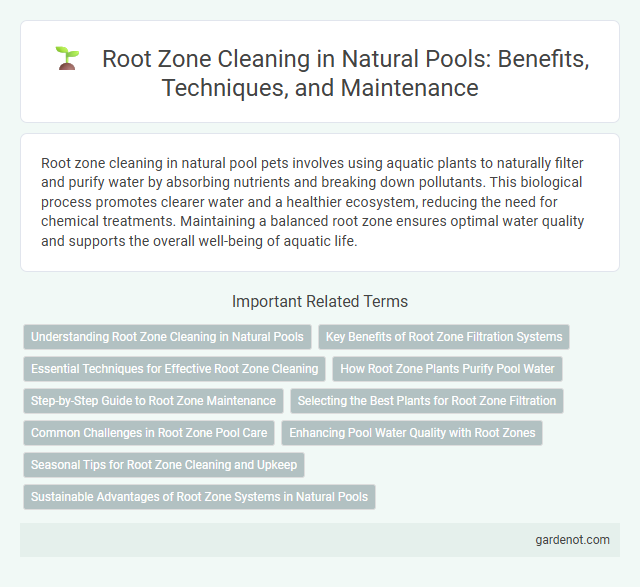Root zone cleaning in natural pool pets involves using aquatic plants to naturally filter and purify water by absorbing nutrients and breaking down pollutants. This biological process promotes clearer water and a healthier ecosystem, reducing the need for chemical treatments. Maintaining a balanced root zone ensures optimal water quality and supports the overall well-being of aquatic life.
Understanding Root Zone Cleaning in Natural Pools
Root zone cleaning in natural pools involves utilizing densely planted zones where aquatic plants absorb nutrients and filter contaminants from the water through their roots. This biological filtration process enhances water clarity and maintains ecological balance by promoting beneficial microbial activity within the root substrate. Understanding root zone cleaning highlights its role in reducing algae growth and supporting a sustainable, chemical-free swimming environment.
Key Benefits of Root Zone Filtration Systems
Root zone filtration systems enhance natural pool water quality by utilizing plant roots and microbial activity to effectively remove nutrients, pathogens, and suspended solids. This biological filtration method reduces algae growth and improves oxygen levels, promoting a balanced aquatic ecosystem. Energy-efficient and chemical-free, these systems offer sustainable water purification while maintaining the natural aesthetic of the pool.
Essential Techniques for Effective Root Zone Cleaning
Essential techniques for effective root zone cleaning in natural pools include periodic removal of accumulated organic matter to prevent anaerobic conditions and maintain water clarity. Utilizing biofiltration systems with native aquatic plants promotes natural breakdown of pollutants and supports microbial communities essential for nutrient cycling. Regular monitoring of sediment layers and targeted aeration enhances oxygen levels, ensuring optimal root zone health and sustainable pool ecosystem function.
How Root Zone Plants Purify Pool Water
Root zone plants purify natural pool water by absorbing nutrients and breaking down organic matter through their extensive root systems, creating a biofilter that reduces harmful bacteria and algae growth. Their roots host beneficial microorganisms that convert pollutants into harmless compounds, maintaining water clarity and ecological balance. This natural filtration process eliminates the need for chemical treatments, promoting a sustainable and healthy aquatic environment.
Step-by-Step Guide to Root Zone Maintenance
Root zone cleaning in natural pools requires precise periodic removal of debris and sediment from the planted filtration area, ensuring optimal water purification efficiency. Begin by carefully lifting sections of the planting medium to eliminate accumulated organic matter and roots, preventing clogging and anaerobic conditions. Consistent maintenance every six months supports healthy plant growth and sustains the natural pool's biological filtration capacity.
Selecting the Best Plants for Root Zone Filtration
Selecting the best plants for root zone filtration in natural pools involves choosing species with extensive root systems and high nutrient uptake capacity, such as cattails, water lilies, and reeds. These plants efficiently absorb organic pollutants and excess nutrients, maintaining water clarity and supporting biological balance. Proper selection enhances natural filtration, reduces algae growth, and promotes a sustainable, eco-friendly swimming environment.
Common Challenges in Root Zone Pool Care
Root zone cleaning in natural pools often faces challenges such as clogging caused by organic debris accumulation and sediment buildup, which impair water flow and filtration efficiency. Maintaining a balanced microbial environment is critical to prevent anaerobic conditions that generate unpleasant odors and harm aquatic plants. Effective management requires regular removal of accumulated matter and monitoring of root zone health to sustain optimal purification and water clarity.
Enhancing Pool Water Quality with Root Zones
Root zone cleaning in natural pools significantly enhances pool water quality by leveraging plants and microorganisms to filter and break down organic matter. This biofiltration process reduces harmful nutrients and contaminants, promoting clear, balanced, and healthy water conditions. Maintaining a robust root zone ecosystem ensures sustainable water purification and minimizes the need for chemical treatments.
Seasonal Tips for Root Zone Cleaning and Upkeep
Seasonal root zone cleaning in natural pools enhances water clarity and plant health by removing accumulated debris and decaying organic matter. Regularly loosen and aerate the substrate during spring and autumn to prevent anaerobic conditions that can harm beneficial microorganisms. Maintaining optimal plant density and trimming dead roots supports a balanced ecosystem and promotes efficient nutrient cycling throughout the year.
Sustainable Advantages of Root Zone Systems in Natural Pools
Root zone cleaning in natural pools harnesses the biological filtration capacity of aquatic plants, promoting sustainable water purification without chemical additives. This system enhances nutrient absorption and sediment stabilization, reducing the need for mechanical filtration and minimizing energy consumption. By maintaining a balanced ecosystem, root zone systems support biodiversity and long-term ecological health in natural swimming environments.
Root zone cleaning Infographic

 gardenot.com
gardenot.com